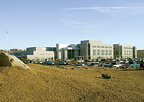
In this atmosphere of growth and prosperity, the Dixie Regional Medical Center saw a need to dramatically expand its services and space. It now occupies a new 400,000-sq-ft hospital and medical office building that will introduce advanced trauma care and tertiary care services, such as open-heart surgery and neurosurgery. The mechanical engineering firm, which served as consulting-specifying engineers on this project, made IAQ one of its top priorities.
Under the direction of John D. Frank, P.E., vice president of Van Boerum & Frank Associates, Inc. (VBFA), Jeff Watkins, P.E., served as project engineer. "Following AIA guidelines for health care design, we must take into consideration patient comfort, the need for a sterile environment in the operating rooms (OR), medical gas needs, and proper humidification", said Frank.
Since the climate in St. George is semi-arid, with summer temperatures averaging between 95°F to 101°, HVAC systems must be designed to maintain a minimum of 30% humidification. "We specified a duct liner that has moisture-repellency characteristics because of the need to maintain our humidity requirements," Watkins said.
CertainTeed ToughGard™ R duct liner with enhanced surface was specified. The mechanical contractor, Western Sheet Metal, installed 300,000 sq ft of the rotary-based fiberglass duct liner. The enhanced surface helps alleviate some specifiers' concerns about moisture that may enter a duct system due to improperly sealed duct joints or poorly installed and maintained duct systems. The airsteam surface contains an EPA-registered antimicrobial agent in order to reduce the potential of microbial growth that may affect this product.
At the peak of the project, Western Sheet Metal devoted 40 people to the fabrication of 600,000 lbs of sheet metal duct work for the medical center. According to Western executive Bruce Montrone, the company completed work on a fast-track, 18-month schedule.
Historic Project
Construction of the new hospital campus, which began in early 2001, cost more than $100 million and was the largest construction project in the history of Washington County. It features 108 patient rooms, a 24-bed intensive care unit, a 30-bed emergency department, and eight ORs. As soon as the doors opened, renovations began at the current campus, which will become a specialty hospital for women's and children's care.
Taking into consideration new jobs created at the hospital and other employment generated in the community by the hospital's opening, Dixie Regional Medical Center will be responsible for 2,000 jobs and $101 million in household earnings in Washington County.
Design And Construction Expertise
VBFA is responsible for the design and specification of not only the HVAC system, but also plumbing, fire protection, and medical gas systems. The new mechanical system is comprised of three McQuay chillers, which were selected by the owner because of their dual compressors. Two dual compressor chillers are rated at 760 tons each, and one single compressor chiller is rated at 350 tons. Watkins noted that the chillers were not the lowest bid for the project, but that the redundancy provided by the dual compressors gave the owner an additional comfort level.Two steam Superior Boilers provide all heating, domestic hot water, and humidification and sterilization for the facility. Nine Temtrol air handlers range in size from 55,000 cfm of air to 85,000 cfm. They were designed with 4-in., double wall construction.
The VAV reheat system consists of medium-pressure duct work, with air passing through the VAV boxes, and then dropping to low pressure, providing optimum comfort control in all spaces. Individual control is provided throughout the facility. All medium-pressure duct work is wrapped with insulation, while all low-pressure supply and return duct work is lined, except for invasive procedure rooms, as indicated by code requirements.
Dixie Regional Medical Center administrator Steve Wilson is proud of this project. "We are excited to benefit from the expertise of our design and construction firms," he said. "This is a once-in-a-lifetime project, and we are committed to constructing the most beautiful, efficient hospital possible to serve the people of Utah's Dixie region."ES
